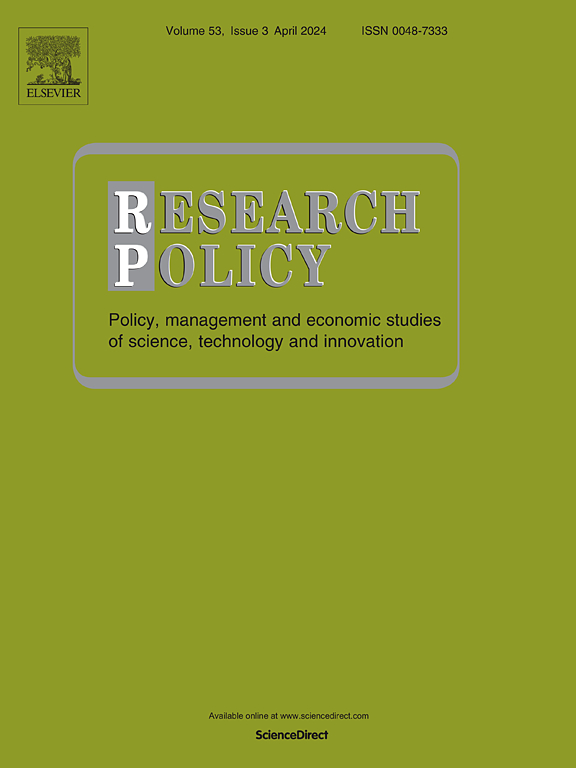开辟道路:描述和评估一种新的政策工具,即间接税收激励推动协作创新
IF 8
1区 管理学
Q1 MANAGEMENT
引用次数: 0
摘要
政府通过直接(即资本赠款)和间接(即对业务收益的税收优惠)补贴来激励研发活动的积极外部性。在这方面,直接补贴通常被认为更明确地旨在通过组建财团鼓励合作创新。然而,在现有的研究中,间接补贴在这一领域的潜力仍未得到充分探讨。此外,这些机制依赖于一个未说明的假设:接受支持的实体是最适合使用支持的。本文通过评估西班牙巴斯克地区比斯开省议会推出的一项名为64Bis的独特研发税收减免倡议,放宽了这些假设。64Bis计划使企业(开发人员)能够将该机制的收益分配给外部组织(融资者)。作为交换,金融家赞助公众支持的研发项目。本文不仅首次描述了这一政策工具,而且利用准自然实验条件来检验群体间和群体内的异质性。使用会计数据和一对一倾向评分匹配分析组间异质性,以构建合成对照组。研究发现,在2017年至2021年期间受益于这一举措的开发商比同期的同类企业获得了更多的知识。使用调查数据和模糊集定性比较分析(fsQCA)来检查组内异质性,以确定通过该政策工具增强知识获取的最佳配置路径。综上所述,研究结果表明,实施研发税收优惠可以促进协同创新体系的形成,并对学术研究和政策制定具有重要意义。本文章由计算机程序翻译,如有差异,请以英文原文为准。
Blazing the trail: Describing and assessing a new policy instrument whereby indirect tax incentives fuel collaborative innovation
Governments incentivize positive externalities from R&D activities via direct (i.e., capital grants) and indirect (i.e., tax incentives for proceeds from operations) subsidies. In this regard, direct subsidies are often presumed to be more explicitly geared toward encouraging collaborative innovation through the formation of consortia. However, the potential of indirect subsidies in this domain remains underexplored in extant studies. Moreover, these mechanisms rely on an unstated assumption: the entities receiving support are the best placed for its use. This article relaxes these assumptions by assessing a unique R&D tax break initiative, called the 64Bis, introduced by the provincial council of Biscay in the Basque Country, Spain. The 64Bis initiative enables an enterprise (Developer) to allocate the proceeds from this mechanism to an external organization (Financier). In exchange, the Financier sponsors the publicly backed R&D project. This article not only describes this policy instrument for the first time but also exploits the quasi-natural experiment conditions to examine between- and within-group heterogeneities. The between-group heterogeneities were analyzed using accounting data and one-to-one propensity score matching in order to construct a synthetic control group. Developers benefiting from this initiative between 2017 and 2021 were found to have acquired more knowledge than comparable enterprises during the same period. The within-group heterogeneities were examined using survey data and fuzzy-set Qualitative Comparative Analysis (fsQCA) to identify optimal configurational pathways that enhance knowledge acquisition via this policy instrument. Altogether, the findings suggest that implementing R&D tax incentives can encourage the formation of collaborative innovation systems, and have significant implications for both academic research and policy development.
求助全文
通过发布文献求助,成功后即可免费获取论文全文。
去求助
来源期刊

Research Policy
MANAGEMENT-
CiteScore
12.80
自引率
6.90%
发文量
182
期刊介绍:
Research Policy (RP) articles explore the interaction between innovation, technology, or research, and economic, social, political, and organizational processes, both empirically and theoretically. All RP papers are expected to provide insights with implications for policy or management.
Research Policy (RP) is a multidisciplinary journal focused on analyzing, understanding, and effectively addressing the challenges posed by innovation, technology, R&D, and science. This includes activities related to knowledge creation, diffusion, acquisition, and exploitation in the form of new or improved products, processes, or services, across economic, policy, management, organizational, and environmental dimensions.
 求助内容:
求助内容: 应助结果提醒方式:
应助结果提醒方式:


